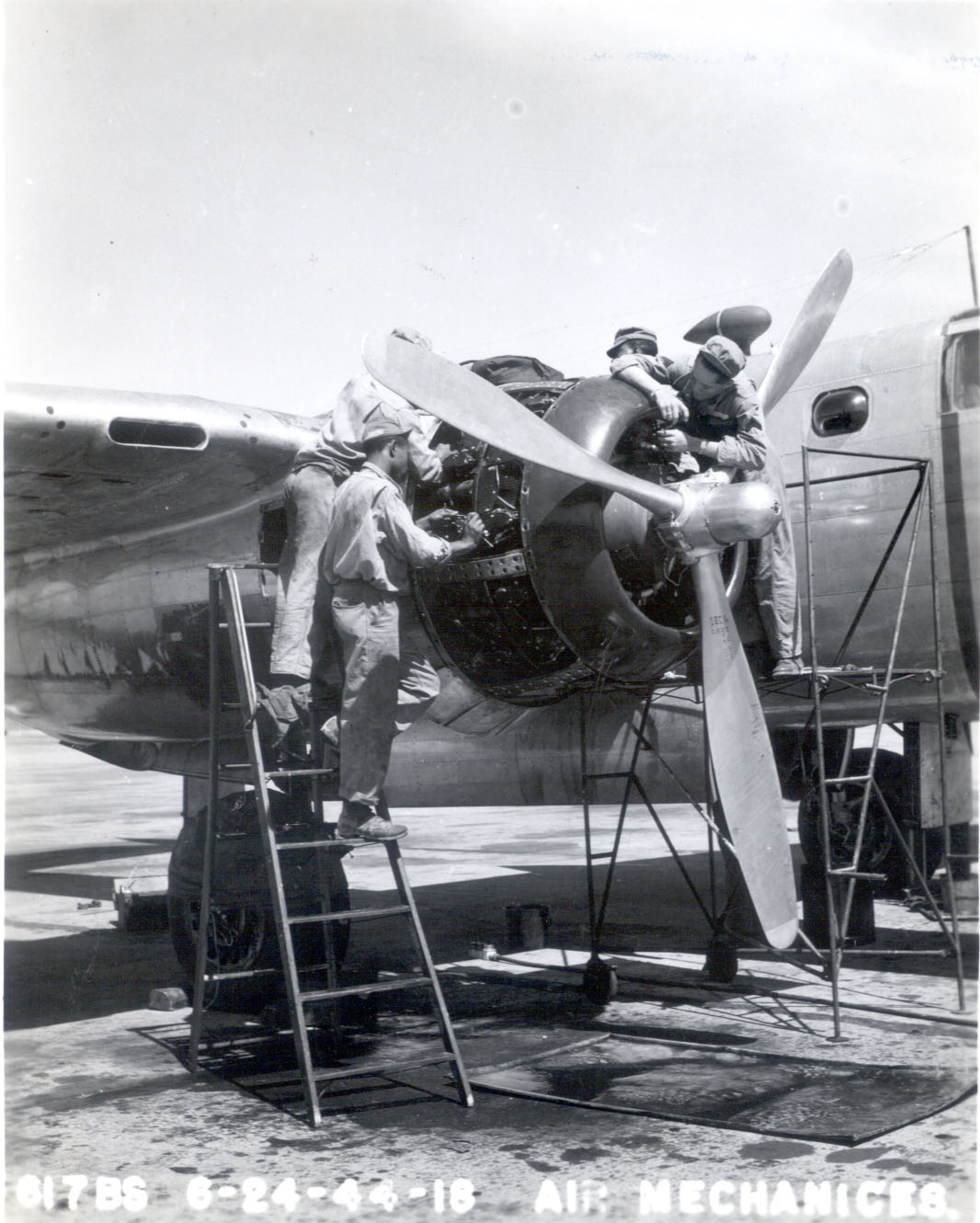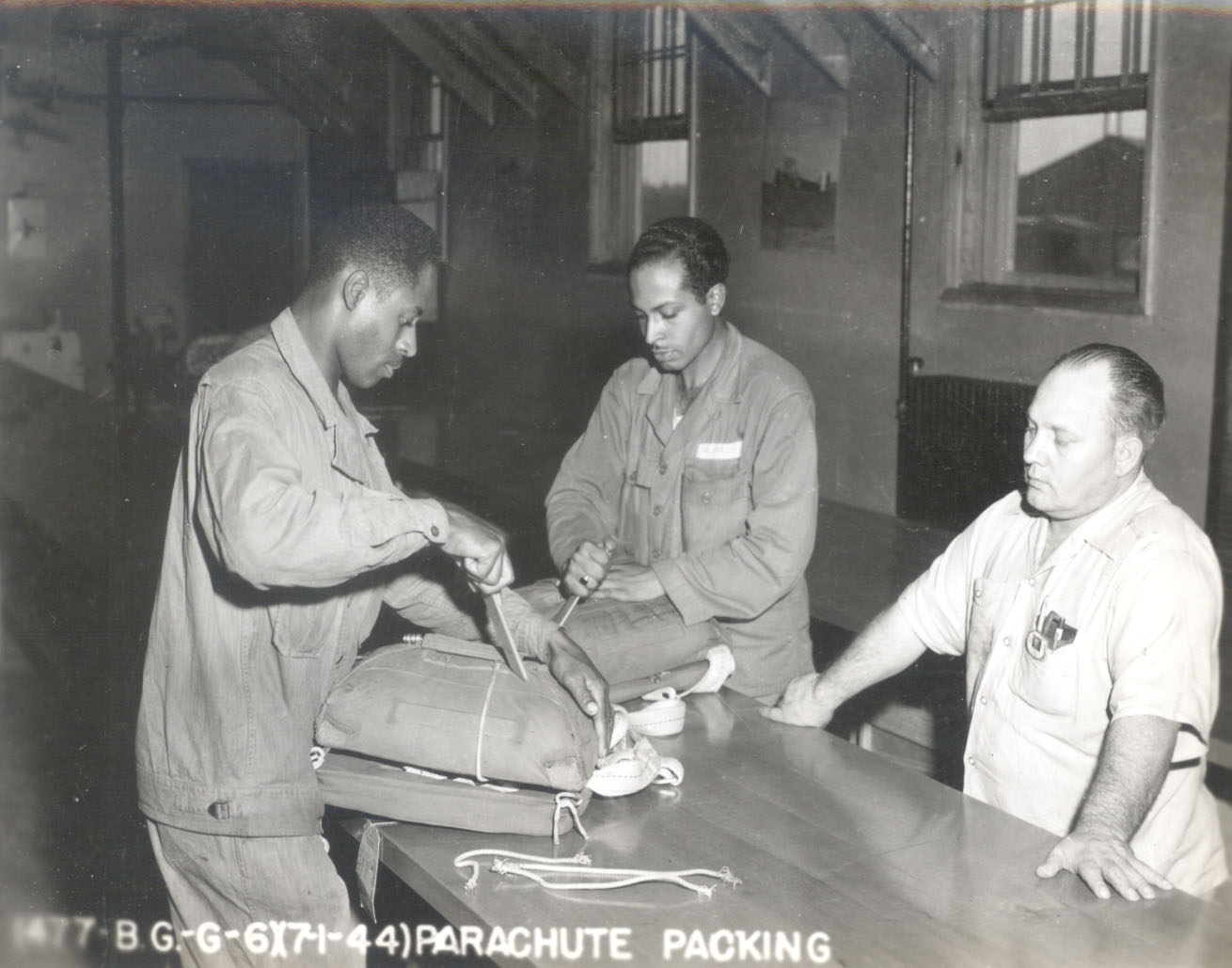The history of the 477th Fighter Group begins with the Tuskegee Airmen, the dedicated, determined young men who volunteered to become America’s first black military Airmen. They came from every part of the U.S., with large numbers coming from New York City, Washington, D.C., Los Angeles, Chicago, and Detroit. Each one possessed a strong personal desire to serve America proudly and to the best of his ability as an Airman, at a time when many white Americans believed that black men lacked intelligence, skill, courage and patriotism.
 Those who possessed the physical and mental qualifications and were accepted for aviation cadet training were trained initially to be pilots, and later to be pilots, navigators, or bombardiers. Most were college graduates or undergraduates, while the remainder demonstrated their academic qualifications through comprehensive entrance examinations. Officials did not lower standards for black pilots and other Airmen trained as operations officers, meteorologists, intelligence officers, engineering officers, flight surgeons, etc. Still others were trained to be aircraft and engine mechanics, armament specialists, radio repairmen, parachute riggers, control tower operators, administrators and for every other type of skill necessary to function as an air force squadron, or ground support unit.
Those who possessed the physical and mental qualifications and were accepted for aviation cadet training were trained initially to be pilots, and later to be pilots, navigators, or bombardiers. Most were college graduates or undergraduates, while the remainder demonstrated their academic qualifications through comprehensive entrance examinations. Officials did not lower standards for black pilots and other Airmen trained as operations officers, meteorologists, intelligence officers, engineering officers, flight surgeons, etc. Still others were trained to be aircraft and engine mechanics, armament specialists, radio repairmen, parachute riggers, control tower operators, administrators and for every other type of skill necessary to function as an air force squadron, or ground support unit.
The black Airmen who became single or multi-engine pilots trained at Tuskegee Army Air Field (TAAF) in Tuskegee, Alabama. The first class of 13 aviation cadets began training in July 1941 and completed nine months later in March 1942. Five successfully completed the training, including Benjamin O. Davis, Jr., a West Point graduate. The other four cadets were commissioned second lieutenants, and all five received Army Air Corps silver pilot wings. From 1942 until 1946, hundreds of cadets trained at TAAF, in all, 992 African-Americans graduated from aviation classes, and received commissions and pilot’s wings. Black navigators, bombardiers and bomber gunnery crews trained at select military bases elsewhere in the United States. Black Americans began training as aircraft and engine mechanics at Chanute Air Base in Rantoul, Illinois in 1941 before being assigned to Tuskegee in 1942, where subsequent mechanics were trained after facilities were in place.
Out of the pilots who trained at Tuskegee, 450 served overseas in either the 99th Pursuit Squadron (later the 99th Fighter Squadron) or the 332d Fighter Group. The 99th FS trained in and flew P-40 Warhawks in combat in North Africa, Sicily and Italy from April 1943 until July 1944 when they transferred to the 332d FG in the 15th Air Force.
The all-black, 332d Fighter Group consisted originally of three fighter squadrons, the 100th, the 301st and the 302d, and prepared for combat at Selfridge Air Base, Michigan from March-December 1943. They trained in P-40 Warhawks and P- 39 Airocobras. The group began overseas combat operations at Capodichino Air Base, Naples, Italy in February 1944 flying P-39 Aircobras. Their mission was air patrol in Naples Harbor and the Mediterranean Sea in the 12th Air Force in May 1944.
In June 1944, the 332d Fighter Group transferred to the 15th Strategic Air Force on the Adriatic Sea side of Italy and stationed at Ramitelli Air Base, Italy. The group became a long-range heavy bomber escort unit. One month later, July 1944, the 99th Fighter Squadron transferred to the 332d FG, and the unit became the only four-squadron fighter group performing bomber escort missions in the 15th Air Force.
This was a significant factor in the effectiveness and success of the 332nd FG as it established the incredible and unprecedented record of flying all of its bomber escort missions (200 over most of central and southern Europe), from June 1944 until April 1945, without the loss of a single bomber to enemy aircraft. The pilots flew P-47 Thunderbolts in June 1944 and P-51 Mustangs thereafter.
The tenacious bomber escort cover provided by the 332d “Red Tail” fighters often discouraged enemy fighter pilots from attacking bombers escorted by the 332d Fighter Group. This resulted in fewer enemy fighter challenges with resultant fewer enemy aircraft destroyed or damaged, as compared with other 15th Air Force fighter escort groups. The successful escort record resulted in frequent expressions of appreciation from the 15th Air Force bomber units and crews. The outstanding record of black Airmen in World War II was accomplished by men whose names were: Davis, Hall, Campbell, Tresville, Pruitt, Gleed, Peirson, Lester, Browne, Archer, McGee, (later James), and many others who will live in hallowed memory. Each one accepted the challenge, proudly displayed his skill and determination while possibly suppressing internal rage from humiliation and indignation caused by daily experiences of racism and bigotry, at home and overseas. The Airmen fought two wars - one against a military force overseas and the other against racism at home and abroad.
After the 332d Fighter Group departed Selfridge Field, Michigan in December 1943 to go overseas, the remainder of the black Airmen personnel on the base comprised mostly of the 477th Medium Bombardment Group trained on the B-25 Medium Bomber. The 477th BG bounced from base to base and experienced racism that perhaps transcended all other World War II racial incidents and prevented them from becoming a deployable unit.
The slights ranged from substandard facilities to exclusion from the Post Exchange (PX) and officer’s club, to the outright hostility of General Frank O.D. Hunter, Commander of the First Air Force.
“As long as I am commander of the First Air Force, there will be no racial mixing at any post under my command,” Hunter said in 1944.
 This may have resulted in heated reactions from the black officers. The memory of the recent race riot in nearby Detroit, Michigan in the spring of 1943 led to the transfer of the 477th Group from Selfridge Field to Godman Field, Kentucky. At Godman, the treatment and hostility continued and in early 1945, the group transferred to Freeman Field in Indiana where hostilities reached a climax.
This may have resulted in heated reactions from the black officers. The memory of the recent race riot in nearby Detroit, Michigan in the spring of 1943 led to the transfer of the 477th Group from Selfridge Field to Godman Field, Kentucky. At Godman, the treatment and hostility continued and in early 1945, the group transferred to Freeman Field in Indiana where hostilities reached a climax.
The white commander of the 477th BG, Colonel Robert Selway helped enforce Hunter’s prejudicial policies. Upon arrival at Freeman Field, Selway divided the officers’ clubs along racial lines. In an effort to disguise this, he said Club Number 1 was open to trainees. All black officers were classified as “trainees” at Freeman Field. Club Number 2 was open to instructors and supervisors. These educated officers were aware of the nation’s burgeoning Civil Rights Movement and made plans to integrate Club number 2.
The incident later known as the Freeman Field Mutiny began when dozens of black officers entered the Freeman Field Base Officers’ Club against direct orders for them to stay out. Selway ordered black officers to sign a statement that they understood his orders regulating segregation of the officers’ clubs. When 101 officers refused to sign, they were subsequently arrested, shipped off to Godman Field for detainment, charged with insubordination, and ordered to face court-martial proceedings. The court-martial charges were quickly dropped against all except three officers; two eventually had their charges dropped, and one, Lieutenant Roger Terry, was convicted.
 Col. Davis and a cadre of 40 officers and Airmen returned June 8, 1945, to the United States to rebuild the 477th Medium Bombardment Group, which would merge with the 332d FG to become the 477th Composite Group (Colored). The change-of-command took place June 24, 1945. Selway was relieved and Davis took over the group. For the first time, the group had black officers in responsible positions.
Col. Davis and a cadre of 40 officers and Airmen returned June 8, 1945, to the United States to rebuild the 477th Medium Bombardment Group, which would merge with the 332d FG to become the 477th Composite Group (Colored). The change-of-command took place June 24, 1945. Selway was relieved and Davis took over the group. For the first time, the group had black officers in responsible positions.
As white air units downsized and personnel either separated or retired from military service the Tuskegee Army Air Base remained segregated and continued to train new Airmen for segregated service until 1946. Large numbers of black Airmen chose to remain in the service after World War II, confined to the 477th Composite Group, and later to the all-black 332d Fighter Wing stationed at Lockbourne Air Base, Columbus, Ohio.
Their welcome at the airfield underscored how pervasive racism was, even in Ohio. The newspaper editor of the Columbus Citizen objected to the arrival of the black Airmen, insisting that “this is still a white man’s country,” and that it was unacceptable for America’s wars to be fought by “servants.” Despite the racism, a 1948 inspection report revealed Lockbourne under Davis’s leadership, “could well serve as a model for bases in the Air Force.”
In May 1947, the 477th Composite Group reverted to being the 332d Fighter Group after disposing of its B-25s. Three months later, the group became the 332d Fighter Wing, and shrank even further in size.
With segregation restrictions, opportunities for advancement and promotion were very limited and this affected morale. Nevertheless, in 1949, a select group of black fighter pilots from the 332d FW took first place in the U.S. Air Force annual National Fighter Gunnery Meet at Las Vegas Air Force Base, Nevada. Myths of black Airmen incompetence, lack of skill, etc., were long forgotten and disproved. Many white units experienced frustration in needing qualified personnel, but were unable to bring into their units the experienced black Airmen because of segregation. Some white air force units had initiated plans to integrate their units in 1947.
In 1948, President Harry Truman enacted Executive Order No. 9981 - Directing equal treatment and opportunity in all of the United States Armed Forces, which in time led to the end of racial segregation in the U.S. military forces. This was also the first step toward racial integration in the United States.
For many, the idea of leaving an all-black unit was daunting, but Col. Davis believed desegregation was the only way to cement the progress his units made. The experience, the record, and the behavior of black American Airmen in World War II, and after, were important factors in the initiation of the historic social change to achieve racial equality in America.
The 477th Fighter Group officially activated Oct. 1, 2007, as an F-22A Raptor unit, continuing the legacy of the Tuskegee Airmen.